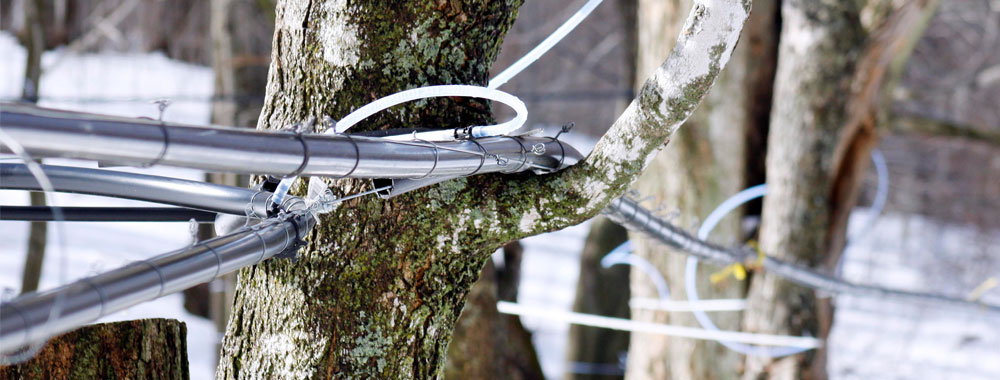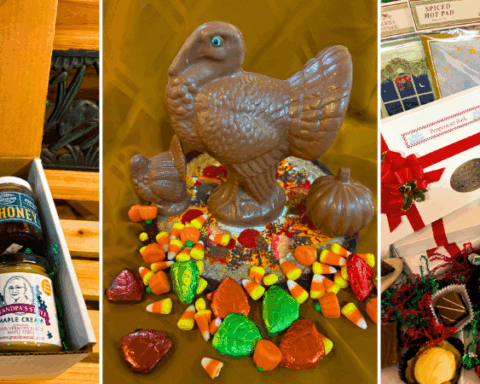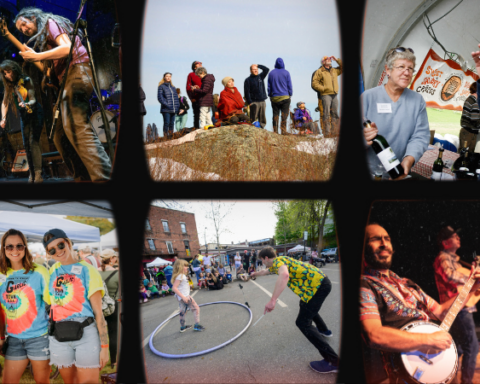By Francesca Shanks
All over New England, thousands upon thousands of maple trees wait like soldiers for the tapping season to begin, their wood linked by miles upon miles of tubing. As the days grow warmer, the slightly sweet, mineral-rich sap those trees spit out runs into sugar houses all over the countryside. Most of that water is destined to boil away into steam, leaving only the sweet, concentrated gold that is 100 percent pure maple syrup.
And from the woods, from the ski slopes, from the cities and towns, come visitors seeking that gold. At Ioka Farm in Hancock, Mass., Terrianne Koepp is ready to receive them.
As a small group files into the sugarhouse on the opening day of the farm’s winter season, Koepp gestures through the window at the mountain that rises above the farm.
“There’s over 250 acres of maple trees up there,” she says, guiding them through an industrial reverse-osmosis setup that enables the farm to quickly produce 100 gallons. Ioka also filters its syrup, which makes a smoother product, free of the natural grit that comes from the syruping process.
The sap comes down in lines, connected and maintained by the Leab family, who have run Ioka since 1936. Koepp explains the constant maintenance they take: lines freeze; snow is waist-deep; mother bears bite the lines open so their cubs can drink the sap; squirrels chew the lines; some taps just stop running or get stuck.

It takes 40 gallons of sap to make one gallon of syrup, and the season spans only a short time, usually from February to April. Ioka runs 14,500 taps and trucks in syrup from another 4,000-tap sugarbush in the area. Koepp says they’re hoping for 8,000 gallons this year, all boiled at the family sugar house on Route 43 near Jiminy Peak.
Koepp and her husband John, who runs the evaporation equipment, have worked at the farm for years, and Terrianne Koepp is a bit of a local celebrity. She’s a quick-moving, quick-talking, memorable figure, delighting years of children on school field trips and weekend visits while teaching them about maple syrup grades. A Boston Globe article hailing her as a “high priestess of maple syrup” hangs on the wall of the sugar house.
Shana Parker, her wife Melissa Parker, and their baby Callen Parker, all of Pittsfield, were at Ioka’s opening day, excited to share their tradition of weekends at the farm with Callen for the first time.
“You’re the heart of this place every weekend,” Shana tells Terri, after Callen smiles his way through tiny tastings of three different maple syrup grades. Shana will later buy a darker syrup flavor, which she favors over the lighter, sweeter grades, made with sap from earlier in the season.
Further north, at Hidden Springs Maple in Putney, Vt., Peter Cooper-Ellis is running a packing house that sells to faraway places like Norway and Switzerland.
“We’ve shipped to Afghanistan,” he says — usually people ordering syrup for family members in the armed services. Along with syrup from its own taps, Hidden Valley gets barrels of syrup from Vermont farms, then packages it with the farmers’ own packaging.
“That’s kind of our thing — to support small family farms and help them take their syrup to an international market,” he says.
Hidden Springs is half of CE Maple, a family syrup company that also includes a 27,000-tap sugaring operation.
“My family has been in the sugar business for my entire life,” he says. Cooper-Ellis spent 35 years working in Silicon Valley before returning to Vermont with the goal of bringing pure Vermont syrup to a wider audience via the Internet.
Now he ships pure, all-natural syrup via Amazon Prime at the rate of about five pallets a week, and also maintains an online store on the company’s website. Hidden Springs also maintains a brick and mortar store in Putney, which, of course, does tastings for a willing public.
It’s important to know what syrup grade you’re partial to, from the light, sweet early-season stuff to the darker, late-season batches. (See below for a guide to syrup grades.) A tasting will help; being able to see and taste different syrup batches will allow you to make an informed choice about what to put on your pancakes.
A wide customer base gives Cooper-Ellis insight into syrup grade preferences across the nation. “People in New England and Vermont actually tend to like the lighter grades, like amber and golden, but nationally it seems the darker flavors are more popular, partly because they have that stronger flavor.”
There’s also been a national trend away from artificial sweeteners like high fructose corn syrup; Cooper-Ellis says he’s seen the market grow as he’s built his business.
“The attitude is shifting,” he says — people are using maple products as a sweetener more and more. “We expect it to continue to grow.”
If you’re really looking for pure flavor, it’s best to buy local. Bigger packing houses often blend syrup from multiple sources.
“It comes out very consistent, but it’s not exceptional,” Cooper-Ellis says. At Hidden Springs, “generally speaking, it is syrup that comes directly from farms we bought it from, or from our farm. So you’re getting a single-source, single-batch syrup.”
Here, where taps line hillside after hillside, this matters. “When people around here taste really good maple syrup, they know it,” she says. •
More About Maple

Recipe: Maple Bread Pudding
If you have toured Ioka Farm in Hancock, Ma., you may have had their bread pudding during a syrup tasting. It’s a great, comforting dessert on a winter day. (Obviously, it begs for ice cream.)
2 cups milk
2 eggs
¾ cup maple syrup
1 tablespoon butter
1 teaspoon vanilla
1 cup bread cubes
Scald milk with butter. Add small amount to eggs and mix, then add all ingredients together. Butter a crockpot, then add all ingredients to crockpot and cook low for four hours. If you like, add some optional ingredients: an orange rind, ½ cup raisins, 1 diced apple, ½ cup walnut, 1 ripe banana, or ½ cup dried cranberries.
Syrup Grades
The Grade A/Grade B maple syrup system was updated by the USDA in recent years. There are now four levels of Grade A, as well as “Grade B suitable for reprocessing.”

- Grade A Golden
- Delicate Taste
- Made from early-running sap, this light, mild syrup is good for candy, frosting, and other super-sweet purposes.
- Grade A Amber
- Rich Taste
- Mid-season syrup great for the breakfast table, with a slightly stronger maple flavor.
- Grade A Dark
- Robust Taste
- Late season with a much stronger maple flavor. Excellent for baking and table syrup.
- Grade A Very Dark
- Strong Taste
- Ultra late-season syrup with an intense flavor. Good for baking and a sweet partner in glazes, roasted vegetables, etc.
Unorthodox Syrup Uses
In coffee, with or without cream
“Maple milk” instead of chocolate milk
On fish, mixed with mustard or BBQ sauce
Drizzle on bread or biscuits
Over an omelet or drizzled on the inside of a breakfast sandwich
1-2 teaspoons mixed with melted butter for caramelized onions
As a sweetener in lemonade












